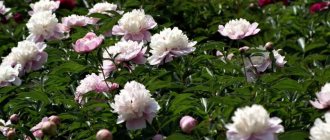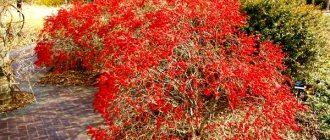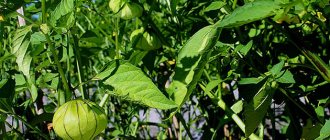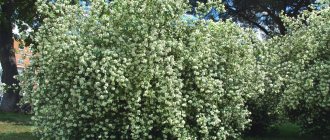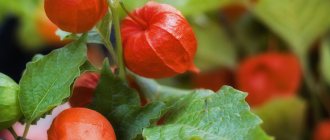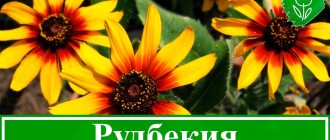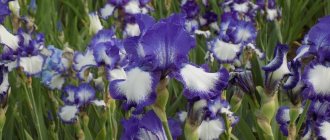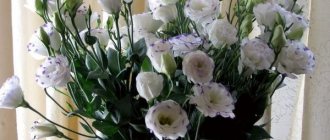Of all the varieties of poppies that exist in nature, the most beautiful and favorite among gardeners is the perennial oriental poppy. Planting and caring for this luxurious flower will not require any special skills or knowledge of agricultural technology. Some difficulties can arise only when transplanting an already mature plant - I want to tell you about these other nuances.
With its beauty, this flower can compete even with a rose, and can simply outshine many common garden inhabitants. Large, rich red poppy buds bloom with the arrival of summer, and the plant's stems can reach a meter in height. Poppy grows in powerful bushes, and thanks to the efforts of breeders, it can now boast a wide range of colors and varied petal textures.
Cream and pink varieties, photo:
Perennial oriental poppy can be propagated by sowing seeds in the ground, dividing the bush, and green shoots. Cuttings (side shoots) must first be rooted; it takes about 2 or 3 years for them to produce color. It is quite difficult to transplant this plant, but it is still possible, despite the fact that it does not react well to being moved from place to place.
Perennial oriental poppy: plant description
This type of poppy is also called low-leaved poppy and is a rhizomatous, perennial, herbaceous plant. It grows wild on mountain slopes in Turkey and Iran, the Caucasus, and can also grow in dry subalpine meadows. The bushes have impressive dimensions; their height can reach about 90 cm.
The stem, which is a peduncle, can be erect or somewhat curved, it can be covered with small leaves, or it happens that it is completely bare. The lower part of the stem is usually covered with whitish hairs.
The bushes are distinguished by powerful roots, which allow them to stay firmly in the soil and provide the flower with nutrients and moisture.
The basal leaves of the plant are lanceolate, oblong in shape with pinnately dissected edges. Their color is light green, the surface is covered with a whitish edge. The leaves on the stems have identical color and shape, only their sizes are much smaller.
During the flowering period, the plant is decorated with single flowers, their diameter can vary from 10 to 20 cm. Each flower has from 4 to 6 petals, quite large, painted in different shades of red, orange-red or rose-red. The petals of some species have a black spot at the base of the flower. The stamens and anthers are elongated and black or dark purple in color.
The lifespan of a flower under favorable weather conditions is about a week; flowering begins, depending on the climate zone, from the beginning of June and can last until mid-July.
The fruits of perennial poppy are very small, dark gray or brown grains, enclosed in an oblong brown or gray-green rounded box.
From above it is covered with a flat bottom. Each of them contains about 9 thousand seeds, their maturity occurs in August.
Description
According to descriptions, Oriental poppy is a perennial, herbaceous plant that belongs to the Poppy family.
It is often called the Eastern papaver poppy, the fact is that poppy in Latin is papaver. Its maximum size can be quite high, averaging 85-95 centimeters.
The leaves have a pale green tint, are large in size, and covered with hard down. The cup-shaped flowers are very large, approximately 18-22 centimeters. Their color is very bright from dark orange to rich red.
General information
Flowering lasts about a month. It most often begins in the second ten days of May and ends in mid-June. In their natural environment, poppies grow on low slopes, near forests. This plant is quite light-loving, but a small shade does not cause damage.
Grows best in light soil containing sand. Excessive soil moisture can be destructive; with excessive watering, the roots can begin to rot.
The legislation of the Russian Federation prohibits the cultivation of oriental poppy throughout the country. You should familiarize yourself with some documents that describe in detail the handling of this plant.
Types of poppy and its varieties
There are a huge variety of oriental poppy varieties, more than two hundred; breeders have worked hard to create luxurious varieties of this wonderful flower.
Garden forms amaze the imagination with the exquisite colors of the petals, from white to purple and lilac, from pink and orange to bright scarlet, in large sizes. Flowers may have smooth, serrated or double petals.
Most varieties of perennial poppy are hybrids.
Among the most popular I would like to note:
- Gardeners' favorite, Mrs. Perry's poppy
- amazing May Queen
- chocolate red Indian chief
- amazing white-flowered variety Perry's White.
They all look great in flower beds and mixborders when planted in groups.
Poppy picoti
This variety has a tall, straight stem that can grow up to one meter. Large poppy flowers are white with a wide orange-red border around the edges. Flowering lasts about two weeks. After the fruits ripen, the seeds spill out and self-sow generously. This variety does not tolerate stagnant moisture. The plant looks beautiful in group plantings. Poppy flowers are also widely used in bouquets.
Where to buy and how to plant perennial garden poppy
You can buy garden poppy seedlings from amateur flower growers on the market; they are sold by garden centers and online stores. If you wish, you can purchase not seedlings, but poppy seeds and grow it yourself.
The plant is not particularly demanding of care and is not afraid of low temperatures.
It is recommended to choose areas for planting perennial poppies that are well lit by the sun, but you can get lush flowering by planting in a slightly shaded area. But when choosing a location, you should take into account that flowers look most advantageous against a background of greenery in brightly lit meadows.
The plant does not really like transplanting, so it is advisable to immediately choose a site where the bushes will grow for many years. An excellent option would be a plot on a small hill - poppies do not like lowlands, constant dampness and stagnant groundwater. If the site is located in a lowland, then you will need to take care of arranging a drainage layer.
Since the flower stalks are quite tall, you should think in advance about installing supports for tying them - this will prevent the flowers from breaking off in strong winds.
Although the oriental poppy will survive in any permeable soil, it, like other plants, will look more attractive when planted in fertile, loose soil.
The application of fertilizers is encouraged, the greenery of the leaves will become brighter, the flowers will be larger. It is advisable to fertilize throughout the entire growing season. The optimal growing period in the same area is from 5 to 7 years, then the plants will need to be transplanted to another place.
Given the tendency to grow, dense plantings should not be done; it is best to plant bushes at a distance of 55-70 cm from each other.
Let's watch an interesting video about perennial poppy and its cultivation:
Peony poppy (Papaver)
This variety is quite cold-resistant, so it is grown in various regions. It does not require special care. To give the foliage a more saturated shade, it is recommended to apply mineral fertilizers to the garden bed. There are specimens with wavy petals in creamy white, pale salmon, purple and white.
Rules of care and watering
We have already mentioned that poppy does not like high humidity, however, the plant needs watering. Although the need for moisture is partially provided by the long root, which goes quite deep into the ground.
The plant is classified as heat-loving, although it can withstand frosts within - 35 C without any shelter.
Transfer
You should not replant the plant frequently.
The bushes are replanted after flowering, in the fall. Since the root of the plant is very long, you will need to dig it out carefully, trying not to disturb the earth ball.
When to prune
Time is devoted to this procedure after flowering has ended. Cut off the stems and leaves at the root, because after flowering they turn yellow and wither, the plant loses its decorative appearance. After some time, young leaves appear above the ground, but their sizes will be much smaller.
They resort to complete pruning if there is no desire to collect the seeds, but if the seeds are collected, then pruning is done only after the crowns have ripened.
Flower care
Planting and caring for perennial oriental poppy is not very difficult. This is an unpretentious plant, for good flowering and growth of which you only need to comply with some agrotechnical rules. The plant requires minimal care, including:
watering;- mulching;
- feeding and fertilizing;
- garter;
- disease control;
- shelter for the winter;
- pruning
Watering and mulching
Poppy is a drought-resistant plant. Thanks to its powerful taproot system, it can easily take moisture from the ground. The good resistance of a flower to drought is facilitated by the presence of hairs in the plant that cover its leaves and stems.
Moderate and regular watering will allow the variety to reveal its full potential. With good watering, the poppy will bloom more abundantly. Excessive watering and stagnation of moisture leads to rotting of the roots and death of the entire plant.
To maintain a humid microclimate, the soil is mulched with peat or compost. This is done around the plant itself. This agrotechnical measure eliminates the appearance of weeds.
Feeding, tying and pruning
Gardeners recommend feeding the flower in the spring. This is the time before the plant begins to grow vegetatively. It is necessary to strictly follow the instructions for applying organic and mineral fertilizers to the soil and observe the recommended amount. Their excess or deficiency can have a detrimental effect on the growth and flowering of the plant.
Varieties characterized by tall growth must be tied up. If this is not done, the poppies break and fall to the ground. This deprives them of their spectacular appearance. After the plant has bloomed, its above-ground part withers and dies. It is customary to cut off the stems and leaves unless collecting seeds is expected. This must be done carefully.
Disease control and winter shelter
Perennial poppy is resistant to pests , so they are rare. The most common diseases that can affect the plant are black leaf spot and root rot. Downy mildew is slightly less common. Parts of the plant that cannot be saved are cut off. The rest is treated with special preparations. The issue of rot can be solved by moderate watering and good drainage.
Poppy is a frost-resistant plant that can withstand temperatures down to -40°. Adults do not need shelter. Only one-year-old immature shoots are subject to it.
Any gardener can plant this beautiful and unpretentious plant on his or her site. You just need to provide it with a small set of necessary conditions for good growth and abundant flowering.
Pests and diseases
Of the insects, only aphids can attack poppy.
But there are quite a few diseases that can affect a plant:
- powdery mildew
- root rot
- black fungal spot
The cause of the disease is often improper care, especially frequent heavy watering.
Detected diseased leaves and parts of roots are immediately cut off and disposed of, to stop the development of the disease, the plants are treated with fungicides, Bordeaux mixture or copper sulfate solution.
Let's watch a video about growing perennial poppy:
LiveInternetLiveInternet
–Search by diary
– Quote book
Walk through the gardens – “Flower jam. “The day will come when you will open your eyes and see: the garden is standing.
The pink country of VDNKh The faded rose breathed sadly, Admiring the sun at the crimson sunset, It moved.
Siamese tulip Siamese tulip. aka Turmeric - it turns out that it’s also a relative of ginger, really.
Gardens for “Flower Jam” The wind plays through the leaves in the branches, The garden greets the dawn with the singing of birds, S.
City flowers. In cities where the dawn is not visible in winter, Where the distance is hidden behind the roofs, In spring.
–Categories
- Sowing and propagation. (291)
- Seeds and seedlings. (149)
- Layering, cuttings, division. (62)
- Fertilizers, fertilizers, compost. (157)
- Master classes, schemes, plans (153)
- Water. (53)
- My flowers. (748)
- Indoor flowers. (455)
- Orchids. (37)
- One- and two-year-old flowers. (174)
- Petunia. (35)
- Perennials. (735)
- Clematis. (52)
- Lilies. (42)
- Weeds. (40)
- Peonies. (35)
- Plodovo-Ogorodnoye. (802)
- Vegetables, herbs. (481)
- Fruits, berries and fruits. (207)
- Trees, bushes. (405)
- Conifers (43)
- Rockeries, other flower beds. (120)
- ROSES. (190)
- Diseases and pests. (219)
- Flower compositions. (162)
- DESIGN. (444)
- DECO ideas. (454)
- Useful TIPS, links. (1008)
- Questions for gardeners. (270)
- Gardens of the world. (182)
- Recipes and herbal medicine. (183)
- Conversations, meetings, exchange. (119)
- Exchange and sale of flowers. (1)
- A little lyricism and romance. (223)
- Download magazines, books, programs. (143)
–Tags
–Links
-Music
–Photo album
– Regular readers
–Broadcasts
-Statistics
Propagation options for perennial poppy
You can propagate poppies:
- cuttings;
- dividing bushes;
- sowing seeds.
The easiest way to grow poppies is from seeds.
Sowing is done either with the onset of spring, or before the onset of frost in the fall. Stronger plants can be obtained if the seeds undergo stratification. For autumn sowing, days are chosen at the end of November, when the temperature does not rise above + 3 +4 degrees C. At higher temperatures, the seeds can sprout, but with the onset of frost, they can die.
Spring sowing is carried out immediately after the snow melts.
They begin work by preparing the soil, clear it of the remains of old roots and pebbles, carefully loosen it, apply mineral and organic fertilizers, humus and compost are suitable.
The grooves for sowing are made shallow, maximum 2 cm deep, otherwise the seedlings may not break through to the surface through the thickness of the soil.
To speed up the germination process, you can cover the crops with plastic wrap. Shoots may appear in 2 weeks; throughout this period it will be necessary to maintain the level of humidity in the garden bed.
To protect the emerging seedlings, you can build a light shelter; film or spunbond will protect the tender seedlings from frost, sun and wind.
To prevent the plants from being too crowded, the seeds can be spread at a distance of 3-5 cm from each other when sowing. If the seedlings are too dense, they are thinned out after the third leaf appears.
Poppies grown from seeds usually bloom in their second or third year.
Vegetative propagation methods require quite careful care; poppy takes root in a new place quite difficult. Flowering is usually observed the next year after planting.
Three to five year old bushes are chosen for division. In this case, it is not recommended to completely dig up the bush; you only need to separate a fragment of the root from the side. Division can be done in early spring, before the buds appear, or in the fall, after flowering has ended. Care should be taken to preserve the fragile root system as much as possible.
The method of dividing the bush is advantageous in that the result is plants that are absolutely identical to the mother plant, preserving all the characteristics of the variety.
When propagating by lateral shoots, it is recommended to keep the cuttings before planting for 24 hours in a solution of root or any other root formation stimulant.
For planting, loose soil is prepared, moistened, the planted cuttings are covered with transparent caps, you can use plastic bottles of mineral water. After roots form, the plants are transplanted to a permanent location.
Sowing and growing from seeds
Sowing is possible in spring or before winter. In the second case, flowers will appear the next year, but earlier than those of plants planted the following spring. Purchased or collected seeds (wrap the seed pods with gauze so that the seeds ripen, but do not spill out) are sown in open ground superficially, almost without deepening. It is enough to lightly crush or press the soil and cover it with covering material. The seeds are small - you can pre-mix them with sand.
It would be a mistake to bury the seeds; the seedlings may not have enough strength to get to the surface.
The seedling method is rarely used. If you decide to grow a plant in seedlings, keep in mind that plants require coolness, plenty of light, and extreme caution when transplanting. Otherwise there shouldn't be any difficulties.
Sowing seeds in the ground in spring is carried out early, before the onset of stable heat; the plant tolerates cold well and even needs stratification.
Young plants require careful, moderate watering.
Why perennial poppy does not bloom, what to do
The reasons may be different, firstly, very young plants spend all their energy on the growth of the rhizome. Usually in the second or third year of life the first flower stalks appear, one or two; only in the 3-4th year will flowering be lush.
Lack of flowering can be observed due to the strong shading of the area.
Proper care plays an important role in the formation of buds; for example, the plant may suffer from too active loosening, which damages the root system.
Features of planting and cultivation
If you want to plant a plant in your dacha, first of all choose the right place. It should be well lit by sunlight and protected from gusts of wind. Now take care of the soil, add humus in advance.
The perennial propagates by seed and by dividing the bush. After the poppy is planted, seeds will fall out of the flowers and the plant will appear again and again.
But this does not mean that poppy care is not needed; such sprouts are often weak and often do not tolerate cold winters. Most often, gardeners grow perennials from seeds, which are sown in late summer, July or August.
It is important to know : if the poppy is not touched, then it can grow in one place for more than ten years.
It is also worth taking care of the permanent place where poppies are grown, since after the first transplant the plant may die. If propagation is carried out by dividing the bush, then this is done in the summer, after the flower has completely faded.
What else you should know: Oriental poppy contains opium
When choosing poppy varieties for planting in the garden, you should keep in mind that some of them contain opioids, which are classified as narcotic substances.
The law prohibits the cultivation of plant varieties containing opium. It is not difficult to identify prohibited varieties; they have a large seed pod. In decorative varieties it is small.
Do not forget that growing oriental poppies may result in an administrative fine if the number of bushes does not exceed 9 pieces. If there are 10 or more plants, the gardener may be prosecuted.
Application in landscape design
Light varieties of poppies look unique, ghostly and mystical; white ones would be appropriate in “moon gardens.”
They go well with flowers of lilac shades, such as irises.
Poppies and miniature irises.
The plant is almost universal, its only serious drawback is the short flowering period and the fragility of the flowers. The latter does not prevent the plant from being popular for cutting - the bright appearance of the oriental poppy outweighs this drawback. In addition to bouquets, it will be good:
- In the flowerbeds.
- In group and single plantings.
- On discounts.
- Mixborders.
- And even in rocky gardens.
Second plan of the border.
Considering the characteristics of poppy, that is, the loss of decorativeness after flowering (the leaves begin to turn yellow), the best place to plant poppy is a skillful combination with other plants that will hide fading bushes or empty space after pruning. These can be any late-flowering perennials:
- asters,
- chrysanthemums,
- cereals,
- daylilies,
- geranium,
- bloodroot.
And also poppy looks great with summer flowers:
- cosmea,
- decorative tobacco,
- kochia.
Poppy can often be seen on the eastern or western side of houses, that is, in partial shade. It really is one of those rare plants that can add bright colors to a slightly shaded area.
Varieties
Turkish or Oriental poppy is in turn divided into the following types:
"Perry White" - the flowers of this variety are white. There is a black spot inside the poppy. The perennial reaches a height of 90 cm.
"Marcus Perry" - belongs to the classics, has bright orange-scarlet flowers, each petal has a black spot at the base. This species also reaches a height of 90 cm.
"Salmon Glove" is a type of double poppy. The color is salmon-orange.
“Goliat” - the same descriptions, only the color of the poppy is red.

